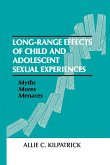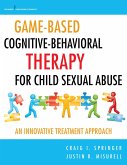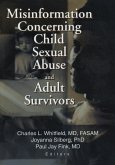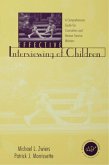Seminar paper from the year 1998 in the subject Psychology - Clinical Psychology, Psychopathology, Prevention, grade: Good, Hendrix College (Department for Abnormal Psychology), course: Independent Study, language: English, abstract: 1. Incidence This first part of the paper deals with the question of how to define child sexual abuse. Differences in the definitions that impede a comparison of different studies conducted on this topic are examined. Child sexual abuse has long been thought to be rare or at least occurring in small numbers only. In recent decades, however, the incidence of child sexual abuse cases seemed to explode. Probably only the higher number of reported cases is responsible for that phenomenon. The incidence of child sexual abuse probably did not really change. The number of child sexual abuse ranges for females somewhere between 6% to 62% and for males between 3% and 31% (Whetsell-Mitchell, 1995; Finkelhor, 1993). The large difference between these numbers is due mainly to the fact of different definitions in the studies. In the following paragraphs three different elements for which definitions seem necessary are discussed. First the phrase child sexual abuse is to be defined. Second phrases for the sexual inappropriate behavior are examined, and third terms to name the abuser are defined. 2. Child Sexual Abuse. A sample of phrases equated with child sexual abuse by different researchers is: sexual victimization, sexual exploitation, sexual assault, sexual misuse, child molestation, sexual maltreatment, and child rape (Whetsell-Mitchell, 1995). Discussion about child sexual abuse becomes even more difficult when different fields are taken into account. The legal and the social welfare system have quite different ideas of child sexual abuse, and these ideas are different from the psychological ideas as well. Some features are more ambiguous than others are. For instance, it is more likely for different people to agree that child sexual abuse has happened when one or the other form of penetration was involved. It becomes more difficult when behavior is examined that might be perfectly normal in one family, while abusive in another family. This depends on the family's idea and practice of nudity. While one family thinks it inappropriate to be naked in front of the child another family might find this perfectly normal. Thus, if one of the parents would approach his or her naked child during bathing, it would be normal in family two but not in the first one. This is largely related to the environment in which the child grew up. One feature that indicates sexual abusive behavior is sexual gratification for the involved adult. [...]
Dieser Download kann aus rechtlichen Gründen nur mit Rechnungsadresse in A, B, BG, CY, CZ, D, DK, EW, E, FIN, F, GR, HR, H, IRL, I, LT, L, LR, M, NL, PL, P, R, S, SLO, SK ausgeliefert werden.









